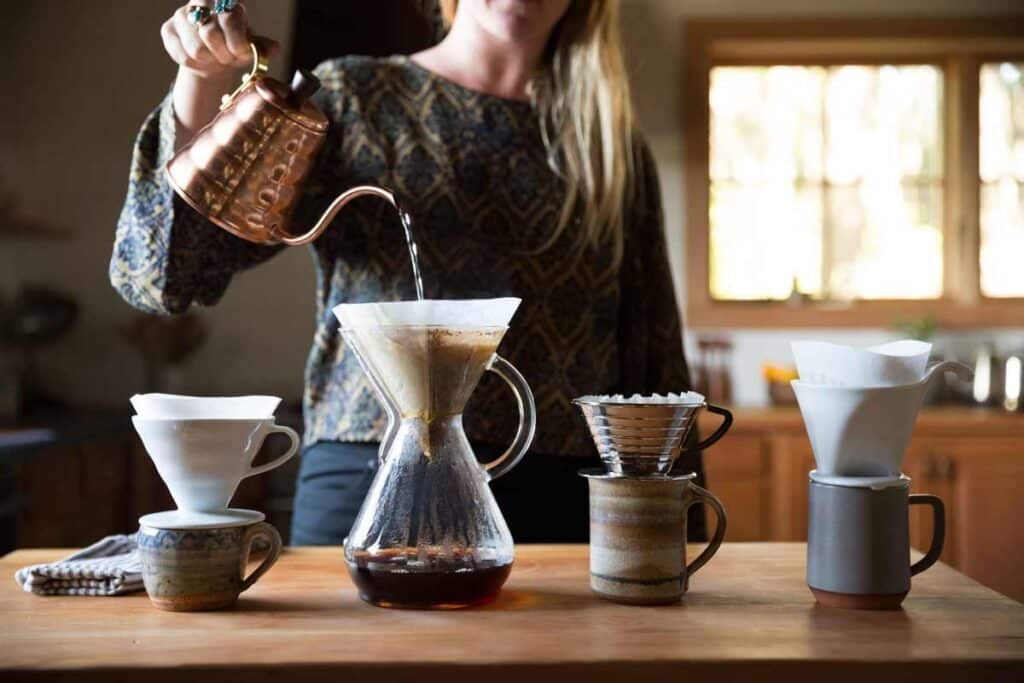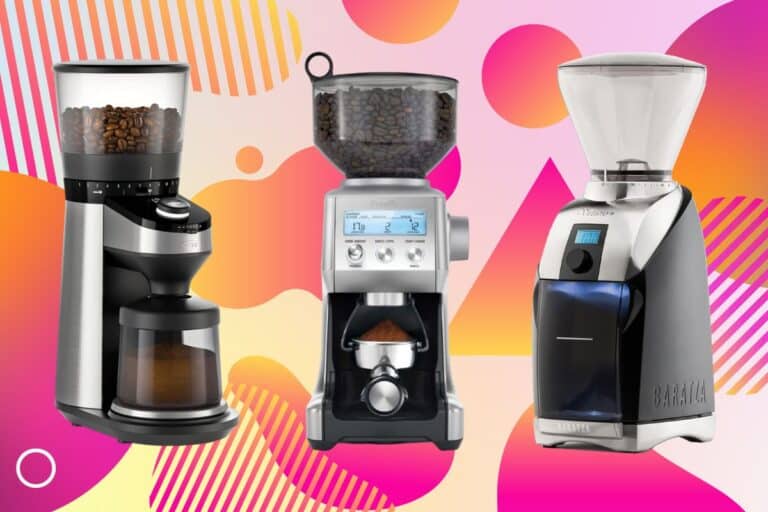Breakfast blend coffee is a type of coffee blend designed to have a lighter flavor profile and moderate acidity that is generally pleasant and enjoyable to sip on, particularly in the morning. Despite its name, breakfast blend coffee can be enjoyed at any time of the day. Not just during breakfast! The name primarily denotes the blend’s nature of being mild and smooth, perfect for starting the day.
The history and origin of breakfast blend coffee are somewhat nebulous, as there’s no fixed rule or standard governing what a breakfast blend should be. In essence, the term “breakfast blend” was primarily a marketing invention designed to appeal to coffee drinkers looking for a smoother and more palatable coffee experience to start their day. It quickly became popular, and now most coffee roasters have their own version of a breakfast blend. Each blend has its own unique combination of beans and roasting techniques.
The Basics of Breakfast Blend Coffee
In coffee terminology, a blend refers to a mixture of coffee beans from different regions or countries. The purpose of blending is to combine the unique flavors and characteristics of different types of beans to create a well-rounded and balanced flavor profile. This allows roasters to control and maintain consistency in flavor, even when the seasonal availability of certain types of beans changes.
General characteristics of breakfast blend coffee
Flavor Profile
Breakfast blend coffee is typically characterized by its mild, smooth, and well-balanced flavor profile. Depending on the specific blend and the roasting process, it can have a wide range of flavor notes. These flavor notes can range from fruity and sweet to nutty and chocolaty. The objective is to achieve a blend that is easy on the palate, especially for the first cup of the day.
Acidity Level
One of the distinctive features of breakfast blend coffee is its moderate to high acidity. This gives the coffee a bright, crisp taste that can be very refreshing. However, the acidity is balanced in such a way that it doesn’t overpower the overall flavor of the coffee.
Caffeine Content
The caffeine content of breakfast blend coffee can vary depending on the types of beans used in the blend and the roasting process. Contrary to what some people might think, lighter roasts, which breakfast blends typically fall under, usually contain slightly more caffeine than darker roasts. This is because the roasting process reduces the caffeine content in the beans, and lighter roasts undergo a shorter roasting process than darker ones. However, the difference is usually small and may not be noticeable to most people.
The Making of Breakfast Blend Coffee

The process of blending coffee
The process of blending coffee requires careful selection, measurement, and combination of different types of beans. Each coffee type is often roasted separately to bring out its unique flavors before being mixed with others. The specific ratios and types of beans used in a blend are usually closely guarded secrets of individual coffee roasters.
Regions from which beans for breakfast blend are sourced
Breakfast blend coffee can be sourced from a variety of regions, each contributing to its distinctive flavor profile. Some common regions include Latin America, particularly Colombia and Costa Rica, for their beans’ mild flavor and high acidity. African beans, especially from Ethiopia and Kenya, are often used for their fruity and wine-like flavors. Additionally, beans from Sumatra or other parts of Indonesia may be included for their earthy and full-bodied characteristics.
Factors that affect the flavor profile of the blend
Several factors can affect the flavor profile of a breakfast blend coffee. The origin of the beans is a major factor, as different regions produce beans with distinctive flavors. The altitude at which the beans are grown can also influence the flavor, with higher altitudes generally producing beans with more acidity and complex flavors.
The process of roasting is another significant factor. Lighter roasts tend to preserve more of the original flavor of the beans, while darker roasts bring out deeper, toasty flavors.
Lastly, the brewing method can significantly influence the taste of the final cup. For example, a French press may produce a richer, fuller-bodied coffee, while a pour-over method may result in a cleaner, more delicate taste.
How to Brew the Perfect Cup of Breakfast Blend Coffee

Several brewing methods are suitable for breakfast blend coffee, each enhancing its unique characteristics:
- Drip or Pour Over: This method often brings out the bright acidity and balanced flavor profile of the breakfast blend, making it ideal for those who prefer a light and clean cup.
- French Press: The French press method allows all the coffee’s natural oils and flavors to be present in the cup, resulting in a full-bodied and rich taste, which can complement the smooth and balanced profile of the breakfast blend.
- AeroPress: AeroPress can produce a coffee with more depth and less bitterness, making the breakfast blend’s subtle flavors more noticeable.
While the name suggests that it is ideal for the morning, breakfast blend coffee can be enjoyed at any time of the day due to its light, smooth, and well-balanced profile. It can serve as a perfect afternoon pick-me-up or even an after-dinner coffee, given its generally lower caffeine content compared to darker roasts.
Breakfast blend coffee pairs well with a variety of foods. Here are a few suggestions:
- Pastries and Bread: The light, balanced flavors of breakfast blend coffee complement the sweetness of pastries and bread, such as croissants, muffins, or toast.
- Breakfast Foods: Traditional breakfast foods, like pancakes, waffles, or eggs, go well with the bright acidity and smooth taste of the coffee.
- Fruits: The coffee’s moderate to high acidity pairs nicely with most fruits, especially berries and citrus fruits.
- Desserts: The mild flavors of the breakfast blend can balance the sweetness of desserts like cookies, cakes, or chocolates without overpowering them.
Common Misconceptions About Breakfast Blend Coffee

While many breakfast blends are light or medium roasts to maintain a smooth, balanced flavor ideal for the first cup of the day, this is not a rule set in stone. The roast level of a breakfast blend can vary based on the roaster’s preference. Some breakfast blends may be darker roasts, providing a more robust flavor while still being balanced and easy to drink.
The caffeine content of coffee is influenced by factors such as the type of coffee bean and the roasting process. Generally, lighter roasts, like many breakfast blends, contain slightly more caffeine than darker roasts. However, the difference is usually minimal and likely wouldn’t be noticeable to the average coffee drinker. Therefore, it’s not accurate to say that breakfast blend coffee categorically contains more caffeine than other types of coffee.
Given that a breakfast blend can be any mix of beans from different regions, each with its unique flavor profiles, it’s a misconception that all breakfast blends taste the same. While they all aim for a smooth, balanced flavor that is easy to drink, the specific taste can significantly differ based on the beans used, the roasting process, and even the brewing method. Therefore, it’s worth trying different brands to find the breakfast blend that suits your palate the best.
The Rise of Breakfast Blend Coffee in Popular Culture

The rise of breakfast blend coffee can be largely attributed to the growing demand for a lighter, smoother cup of coffee that’s easy to enjoy in the morning. As specialty coffee became more popular, consumers began to appreciate the nuances and diversity of coffee flavors. Coffee roasters responded by crafting blends like the breakfast blend, which could offer a complex yet balanced flavor profile. Marketing strategies by large coffee companies also played a role in promoting breakfast blends and making them a staple in many households.
Breakfast blend coffee has significantly impacted coffee culture and morning rituals. With its lighter and more palatable profile, it has appealed to a broad audience, including those who might find stronger coffees too intense. It has become a morning favorite, often associated with the start of a new day. Its popularity has also sparked interest in coffee blending and tasting, encouraging coffee lovers to explore and understand the vast world of coffee flavors.
The popularity of breakfast blend coffee has extended to the entertainment industry as well. Celebrities and influencers often endorse their favorite blends, further driving the trend. Additionally, the coffee culture, including the enjoyment of a morning cup of breakfast blend, is frequently portrayed in films and TV shows, reinforcing its image as a comforting, everyday luxury. For instance, in popular TV shows like “Friends” or “Gilmore Girls”, characters are often seen starting their day with a cup of coffee, reflecting the social and cultural significance of this morning ritual.
The Environmental and Ethical Aspects of Breakfast Blend Coffee

Sustainability in coffee production is an increasingly important concern. This includes environmentally friendly farming practices, like reducing the use of pesticides, preserving local ecosystems, and minimizing water usage. However, due to coffee’s popularity and the demand for low prices, many coffee farms may resort to practices that are harmful to the environment. It’s crucial that both producers and consumers pay attention to sustainable practices to ensure the long-term availability of this beloved beverage.
Fair trade is an essential concept in the coffee industry. It ensures that farmers are paid a fair price for their coffee. This can in turn promotes better working conditions and social development in farming communities. This is particularly important in the case of coffee. A significant portion of global coffee production is carried out in developing countries where farmers are vulnerable to exploitation.
Consumers can play a significant role in promoting both sustainability and fair trade in the coffee industry. Here are some ways to ensure you’re buying ethically sourced breakfast blend coffee:
- Look for certifications: Certifications like Fairtrade, Rainforest Alliance, or Organic indicate that the coffee has met certain standards for sustainability and ethical trading.
- Buy from reputable roasters: Many coffee roasters are committed to ethical sourcing and will provide information about where their coffee comes from and how it’s grown.
- Do your research: Don’t hesitate to ask questions or do your own research. Many companies now offer detailed information about their sourcing practices on their websites.
By making informed choices, consumers can enjoy their breakfast blend coffee while also supporting a more sustainable and fair coffee industry.
Conclusion
The article has covered various aspects of breakfast blend coffee, from its general characteristics and the process of blending, to popular brands, how to brew the perfect cup, and common misconceptions. We have also touched upon the rise of breakfast blend coffee in popular culture, the ethical and environmental implications of coffee production, and how consumers can ensure they’re supporting sustainable and fair trade practices when buying coffee.
Understanding what breakfast blend coffee is allows us to appreciate the craftsmanship that goes into creating a balanced and enjoyable blend. It also helps us make informed choices about what we buy and consume, considering factors beyond just taste, like the ethical and environmental implications of coffee production. As coffee lovers, this knowledge can enhance our coffee-drinking experience and encourage us to explore and appreciate the diverse world of coffee flavors. Whether it’s the first cup of the day or an afternoon pick-me-up, each cup of breakfast blend coffee offers a moment of enjoyment and a connection to a wider global story.






